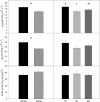Physiological and Transcriptional Responses to Saline Irrigation of Young 'Tempranillo' Vines Grafted Onto Different Rootstocks
- PMID: 35734259
- PMCID: PMC9207310
- DOI: 10.3389/fpls.2022.866053
Physiological and Transcriptional Responses to Saline Irrigation of Young 'Tempranillo' Vines Grafted Onto Different Rootstocks
Erratum in
-
Corrigendum: Physiological and transcriptional responses to saline irrigation of young 'Tempranillo' vines grafted onto different rootstocks.Front Plant Sci. 2022 Sep 26;13:1011533. doi: 10.3389/fpls.2022.1011533. eCollection 2022. Front Plant Sci. 2022. PMID: 36226277 Free PMC article.
Abstract
The use of more salt stress-tolerant vine rootstocks can be a sustainable strategy for adapting traditional grapevine cultivars to future conditions. However, how the new M1 and M4 rootstocks perform against salinity compared to conventional ones, such as the 1103-Paulsen, had not been previously assessed under real field conditions. Therefore, a field trial was carried out in a young 'Tempranillo' (Vitis vinifera L.) vineyard grafted onto all three rootstocks under a semi-arid and hot-summer Mediterranean climate. The vines were irrigated with two kinds of water: a non-saline Control with EC of 0.8 dS m-1 and a Saline treatment with 3.5 dS m-1. Then, various physiological parameters were assessed in the scion, and, additionally, gene expression was studied by high throughput sequencing in leaf and berry tissues. Plant water relations evidenced the osmotic effect of water quality, but not that of the rootstock. Accordingly, leaf-level gas exchange rates were also reduced in all three rootstocks, with M1 inducing significantly lower net photosynthesis rates than 1103-Paulsen. Nevertheless, the expression of groups of genes involved in photosynthesis and amino acid metabolism pathways were not significantly and differentially expressed. The irrigation with saline water significantly increased leaf chloride contents in the scion onto the M-rootstocks, but not onto the 1103P. The limitation for leaf Cl- and Na+ accumulation on the scion was conferred by rootstock. Few processes were differentially regulated in the scion in response to the saline treatment, mainly, in the groups of genes involved in the flavonoids and phenylpropanoids metabolic pathways. However, these transcriptomic effects were not fully reflected in grape phenolic ripeness, with M4 being the only one that did not cause reductions in these compounds in response to salinity, and 1103-Paulsen having the highest overall concentrations. These results suggest that all three rootstocks confer short-term salinity tolerance to the scion. The lower transcriptomic changes and the lower accumulation of potentially phytotoxic ions in the scion grafted onto 1103-Paulsen compared to M-rootstocks point to the former being able to maintain this physiological response in the longer term. Further agronomic trials should be conducted to confirm these effects on vine physiology and transcriptomics in mature vineyards.
Keywords: Vitis vinifera L. (grapevine); gas exchange; gene expression; osmotic adjustment; salinity tolerance; water relations.
Copyright © 2022 Buesa, Pérez-Pérez, Visconti, Strah, Intrigliolo, Bonet, Gruden, Pompe-Novak and de Paz.
Conflict of interest statement
The authors declare that the research was conducted in the absence of any commercial or financial relationships that could be construed as a potential conflict of interest.
Figures




References
-
- Abbaspour N., Kaiser B., Tyerman S. (2013). Chloride transport and compartmentation within main and lateral roots of two grapevine rootstocks differing in salt tolerance. Trees 27 1317–1325. 10.1007/s00468-013-0880-2 - DOI
-
- Allen R. G., Pereira L. S., Raes D., Smith M. (1998). Crop evapotranspiration-Guidelines for computing crop water requirements-FAO Irrigation and drainage paper 56. FAO Rome 300:D05109.
-
- Askri H., Daldoul S., Ammar A. B., Rejeb S., Jardak R., Rejeb M. N., et al. (2012). Short-term response of wild grapevines (Vitis vinifera L. ssp. sylvestris) to NaCl salinity exposure: changes of some physiological and molecular characteristics. Acta Physiol. Plant. 34 957–968. 10.1007/s11738-011-0892-8 - DOI
-
- Baeza P., Sánchez-de-Miguel P., Centeno A., Junquera P., Linares R., Lissarrague J. R. (2007). Water relations between leaf water potential, photosynthesis and agronomic vine response as a tool for establishing thresholds in irrigation scheduling. Sci. Hortic. 114 151–158. 10.1016/j.scienta.2007.06.012 - DOI
LinkOut - more resources
Full Text Sources

